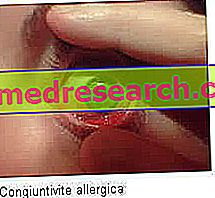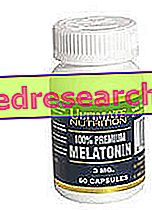Diagnosis of allergic conjunctivitis
Unlike other forms of inflammation in the conjunctiva, allergic conjunctivitis is relatively simple to diagnose: the onset symptoms are in fact quite characteristic and easily recognizable.

Let us briefly recall that the allergic-based conjunctivitis differs precisely on the basis of the causative agent (ie the allergen that caused it): pollen, dust mites, the epithelium of domestic animals or some substances contained in the lenses contact or in certain cosmetics may cause allergic reactions to conjunctiva in sensitive patients.
The diagnosis begins with a careful eye examination supported by the anamnesis, that is the collection of information and symptoms reported by the patient. To complete the visit, the subject is normally subjected to more detailed investigative tests, in order to identify precisely the allergen responsible for the allergic reaction. For this purpose, it is necessary to carry out a series of tests in the laboratory:
- Prick-test: this diagnostic analysis involves the injection on the skin surface of a small amount of the substance considered responsible for allergic conjunctivitis. The possible appearance of an allergic skin reaction with redness, edema and itching is the positive test.
- Tear fluid test: it allows to identify the presence of IgE (type E immunoglobulins) directed against a given allergen.
- Conjunctival provocation test: performed by putting the conjunctiva in contact with a very small quantity of "suspect" substance. When the patient is allergic to that substance, the symptoms of allergic conjunctivitis (eye redness, intense itching and eyelid swelling) suddenly appear or become acute again.
Differential diagnosis
Although the diagnosis is quite simple, it is not uncommon for allergic conjunctivitis to be confused with a disease with related symptoms. To avoid mistaking the cure, it is essential to ascertain the diagnosis and, where possible, identify the responsible allergen.
The differential diagnosis must be set with:
- Viral conjunctivitis
- Bacterial conjunctivitis
- Uveitis
- Acute glaucoma
- Keratitis (corneal inflammation)
- Sclerite (inflammation of the sclera)
- Orbital bacterial cellulite
- Dry eye syndrome
Therapy: how is it treated?
The therapy par excellence against allergic conjunctivitis consists in avoiding or minimizing contact with the responsible allergen; if necessary, it is advisable not to wear contact lenses and not to apply make-up until the origin of the allergic reaction has been ascertained.
The therapy - of exclusively medical competence - makes use of ophthalmic ointments / antiallergic eye drops (to reduce itching) and corticosteroids (to exercise a powerful flaming action).
ANTI-ALLERGIC COLLIRES are prepared with antihistamine active ingredients; the most indicated are: Ketotifene (eg. Zaditen), Sodium Chromoglycate (eg Lomudal Collirio), Emedastina (eg Emadine) and Olopatadine (eg Opatanol).
Although not acting in any way on the triggering cause, CORTICOSTEROID COLLIRES (eg Cortisone, Triamcinolone, Dexamethasone) are essential drugs for healing purposes because they are able to determine a powerful anti-inflammatory action at the ocular level, alleviating symptoms such as swelling and redness in a short time .
In the presence of a particularly aggressive form of allergic conjunctivitis, it is conceivable a double therapy consisting in the combined use of eye drops (topical application) and tablets taken by mouth (by mouth).
Did you know that ...
Antihistamine eye drops work by blocking the action of histamine, a powerful chemical mediator involved in allergic and inflammatory phenomena. In doing so, antihistamines prevent or alleviate the symptoms of the allergic reaction.
When the symptoms of the allergic reaction are rather bearable, it is possible to resort, for some days, to products of free sale that combine vasoconstrictors and antihistamines.
DECONGESTING COLLIRES / VASOCOSTRITORS - which act by inducing a narrowing of the blood vessels of the conjunctiva - removes in a relatively short time the characteristic symptoms of allergic conjunctivitis, namely tearing, hyperemia (eye redness) and swelling.
Prevention
The management of allergic conjunctivitis is essential to prevent secondary eye damage to the allergic-inflammatory response.
When used before the arrival of spring, antihistamine eye drops can prevent the onset of conjunctivitis due to allergic rhinitis, pollinosis or hay fever. As we know, spring allergic conjunctivitis presents a seasonal incidence: in this regard, sensitive patients should undertake a prophylactic therapy already during the first weeks of March through moderate and regular application of antihistamine drops.
Allergic conjunctivitis induced by hypersensitivity to substances contained in cosmetics or contact lenses can be prevented by avoiding contact with these products: contact lenses can be replaced with eyeglasses, while the choice of make-up products it must be addressed exclusively to hypoallergenic ones.
Remedies, tips, warnings
Following are some remedies and practical tips to speed up the health of the eyes affected by allergic conjunctivitis:
- Always respect the indications provided by the doctor and the dosage (dosage): an excessive use of vasoconstrictor drugs, for example, can paradoxically cause the opposite effect, thus ending up worsening the symptoms of congestion.
- Despite being free sale products, decongestant eye drops and vasoconstrictors must be used with extreme caution by patients suffering from hyperthyroidism, hypertension, diabetes and heart problems. For this reason, the advice is to always consult your doctor before instilling any eye drops in the eye.
- To reduce swelling and conjunctival congestion, delicate chamomile packs are very suitable to provide immediate relief. It is recommended to use a clean cotton ball for each pack.
- Protect your eyes with sunglasses with UV filters
- Wash your hands thoroughly before touching your eyes
- Do not scratch your eyes
- Do not use expired or opened eye drops for more than 7 days
- Avoid wearing contact lenses during the entire duration of allergic conjunctivitis therapy (unless otherwise advised by your doctor).



